
Confronting the Years: A Photographer’s Tour of Japan’s Hyper-Aging Society
The Inspiration of 90-Year-Old Gymnastics Instructor Kikuchi Kazuko
People Images Health- English
- 日本語
- 简体字
- 繁體字
- Français
- Español
- العربية
- Русский
A “Gymnastics of Life” Half a Century in the Making
The first thing you notice about Kikuchi Kazuko when she walks into the room is her perfect posture. She stands bolt upright, an unswerving line seeming to stretch all the way from the soles of her feet to the crown of her head. She looks as though she’s never slouched in her life.
Perhaps our posture reflects something of our true character, the way we “carry ourselves” through life. In that sense, perhaps what you see is what you get. When she starts to move, the tension in the room rises as her focused, unruffled attitude communicates itself to the air around her.
“Use your glutes to stretch your backbone straight as it rises from between those two muscles,” she instructs. “When you move, you want to hold your whole body straight with your spine, supported by your glutes. Every part of your body needs to be connected to your brain and your conscious thought at all times.”

The evident pleasure Kikuchi takes in her body and its movements communicates itself to everyone around her. (© Ōnishi Naruaki)
Kikuchi Kazuko is now 90 years old. She says she never dreamed that her style of calisthenics and gymnastics exercises would last this long and have such a dramatic impact on so many people’s lives. Over the years, plenty of new keep-fit fads have come and gone. But Kikuchi’s approach was always different. Soon after giving her first classes, her life was taken up with running her studios and culture centers in Tokyo and Kanagawa Prefectures, appearing on television, and giving interviews, lectures, and talks. Fifty years later, her unique approach to maintaining mental and physical strength into old age remains as popular and influential as ever.
Her attitude, spirit, and words have inspired countless people over the decades, and her legions of fans continue to place faith in her approach as the secret to a long life of physical and mental strength and resilience. What is the secret to the success of Kikuchi’s calisthenics, which has been called a “gymnastics of life”?
A Handshake Between Fingers and Toes
One important aspect of Kikuchi’s exercises is built on something we don’t often notice in our daily lives: the close connections between our fingers and toes.
“Tell me,” Kikuchi says one day, addressing a class: “Isn’t it fair to say that most of you tend to neglect your toes? Our fingers and toes are full of capillary blood vessels that carry energy to our extremities. You need to consciously connect each toe with your brain, and make sure that each toe is doing its job. No lazy toes allowed! Wiggle them one by one, letting your strength go into each toe in turn. The body may weaken with age, but these feet and toes are the only ones we have. We want to them to carry us through the rest of our lives, right till the end.”
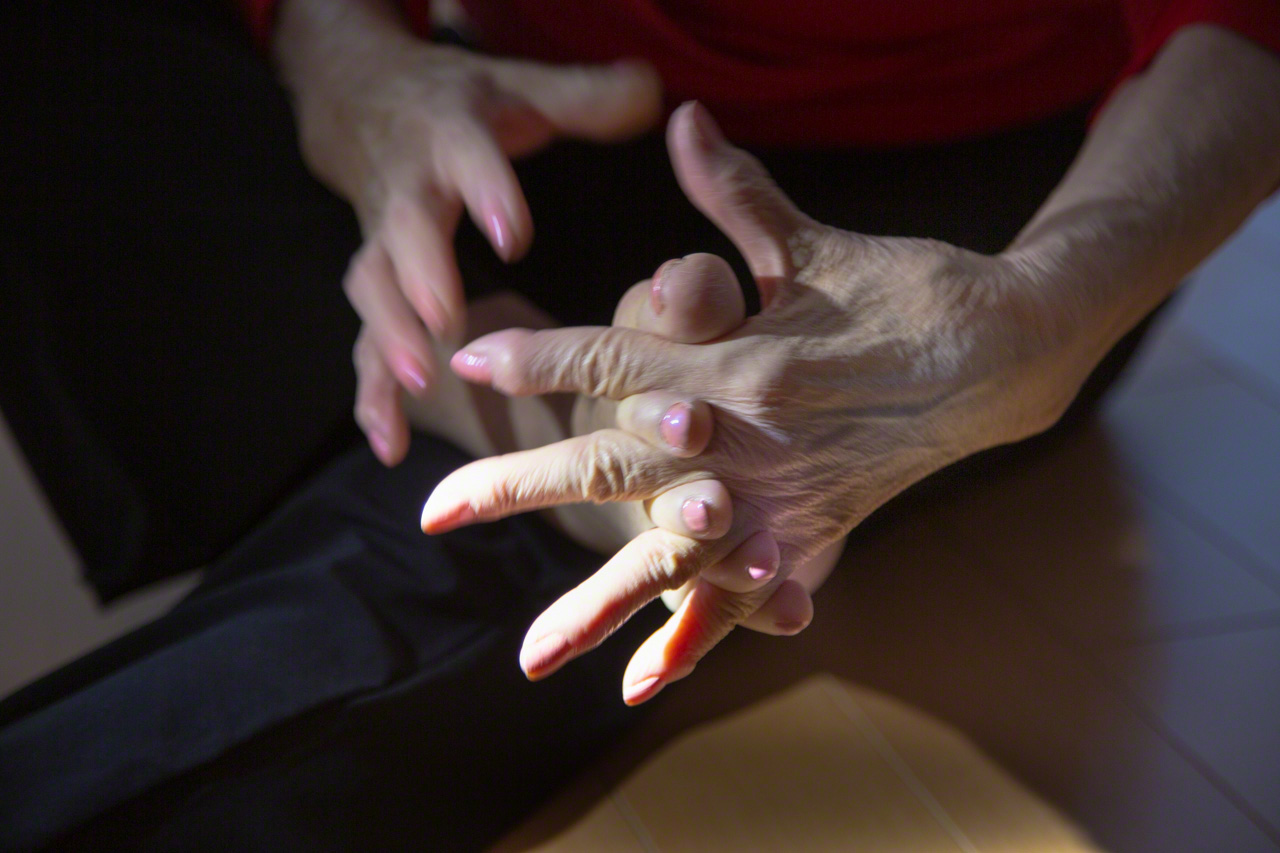
A “handshake” between the left hand and right foot. The key is to make sure that the fingers grip tightly at grip the toes tightly around their base. (© Ōnishi Naruaki)
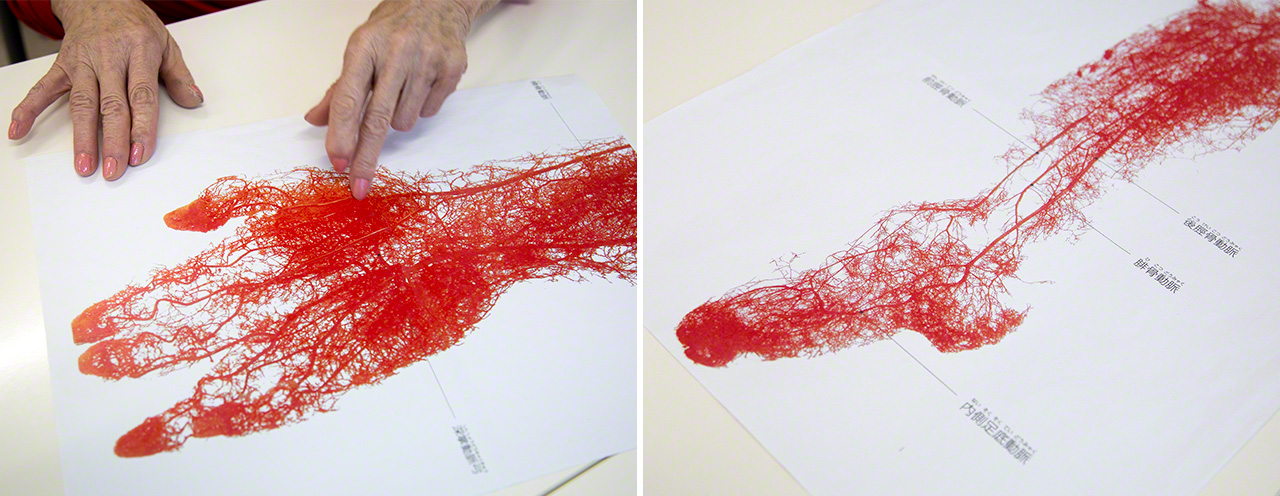
Illustrations of the capillary blood vessels in a human hand (left) and foot. The illustrations show how a thick network of blood vessels runs all the way to the very tips of our fingers and toes, like the branching veins in a tree. (© Ōnishi Naruaki)
Kikuchi has her students intertwine their fingers and toes, so that the right foot and left hand are locked in a kind of embrace. If you try it yourself, you may be surprised by a refreshing sense of the interconnectedness between these two extremities of the body.
Next, Kikuchi’s students rotate their ankles through wide sweeping arcs, activating the joints. Kikuchi’s lessons always start with this warmup routine. She and her students rotate their joints together, the studio echoing to the sound of Kikuchi’s voice as she counts in her elongated style: “Iiiiiichi, niiiiii, saaaaan . . .” Students refer to it as the “Kikuchi orchestra,” and say the sound of Kikuchi’s steady counting provides just the right injection of energy and bounce to get classes off to a lively start.
Good Posture the Key to Inner Health
“All of us began as a single fertilized egg cell,” Kikuchi says. “From that simple beginning we developed into these complex bodies with intricately interlocking networks of organs and body parts. Every human body is a kind of miracle. Our bodies are unique: In the whole universe, there’s no one with a body quite like yours or mine. That’s why it’s so important to cherish our bodies until the very end of our lives. If a part of our body starts to weaken or atrophy, we need to focus our consciousness on restoring its proper movement. That is what my approach is all about.”
Kikuchi gymnastics is different from simple stretching, or workouts designed to build strength and bulk. Her aim is to understand the structure of the body, to use the brain to consciously target a particular bone or muscle, and to use the strengths of the individual’s body and mind to repair and strengthen any parts that are starting to weaken. Kikuchi gymnastics sees the body as a microcosmos and attempts to give the conscious mind free rein to reach into every nook and cranny of this microcosmos. Suddenly, all the preconceptions associated in my mind with the word “gymnastics” are swept away by this breath of fresh air.
We are given a demonstration of how posture affects the position of the organs inside the body by Kikuchi’s eldest daughter, Ōta Nobuko, herself an instructor in Kikuchi gymnastics. For the demonstration, she wears a special leotard bearing a life-size anatomical illustration of the insides of the body.
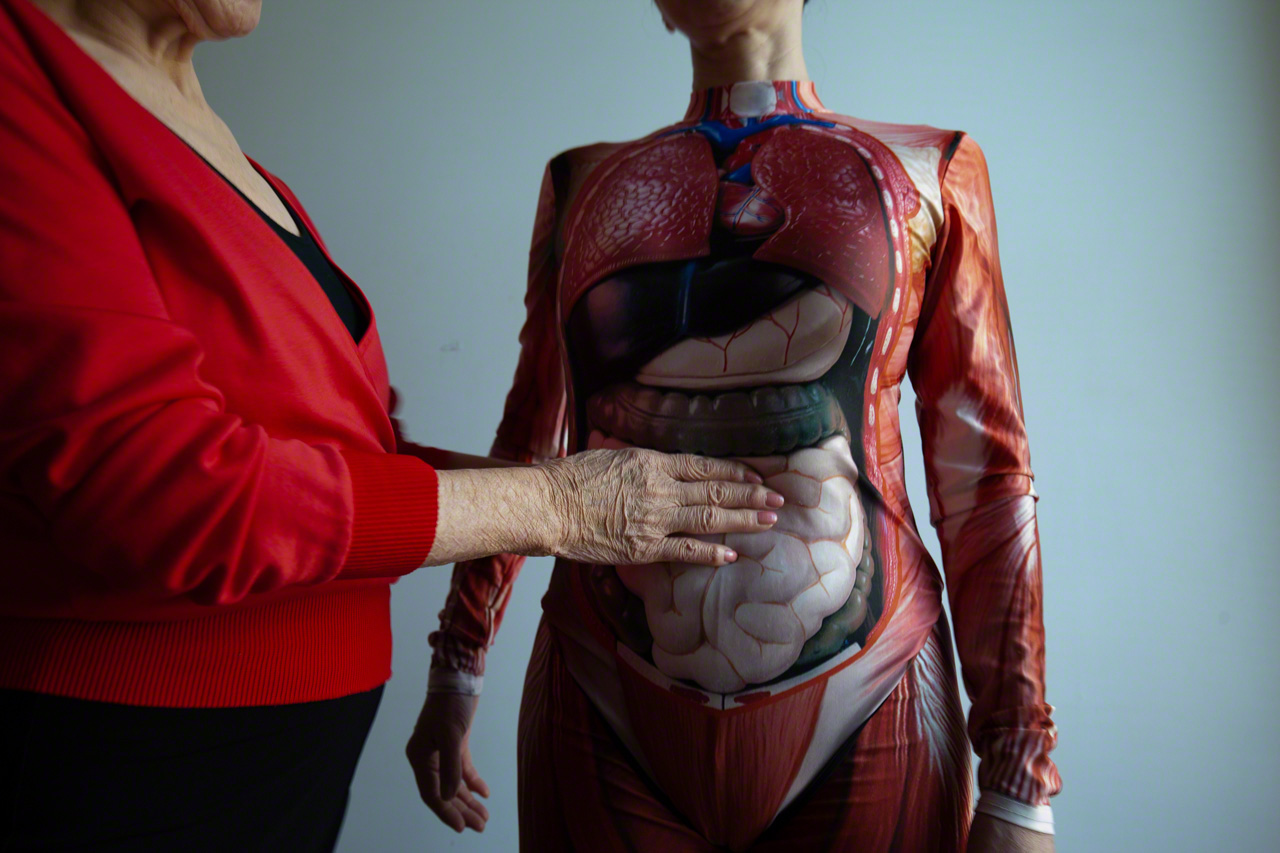
This anatomical leotard makes the close relationships between the skeleton, musculature, and organs immediately visible. (© Ōnishi Naruaki)
The two photographs below show what a difference posture can make. The photo on the left shows the pose typical of our modern lives, in which many of us spend hours at a desk every working day. The spine is bent, the body slumped forward. The picture shows the shocking extent to which the organs are squeezed and cramped inside the body. The picture on the right shows how sitting with your backbone straight and being aware of your body and internal organs can help you to relax and ease the stress and strain you are putting on your body and internal organs.
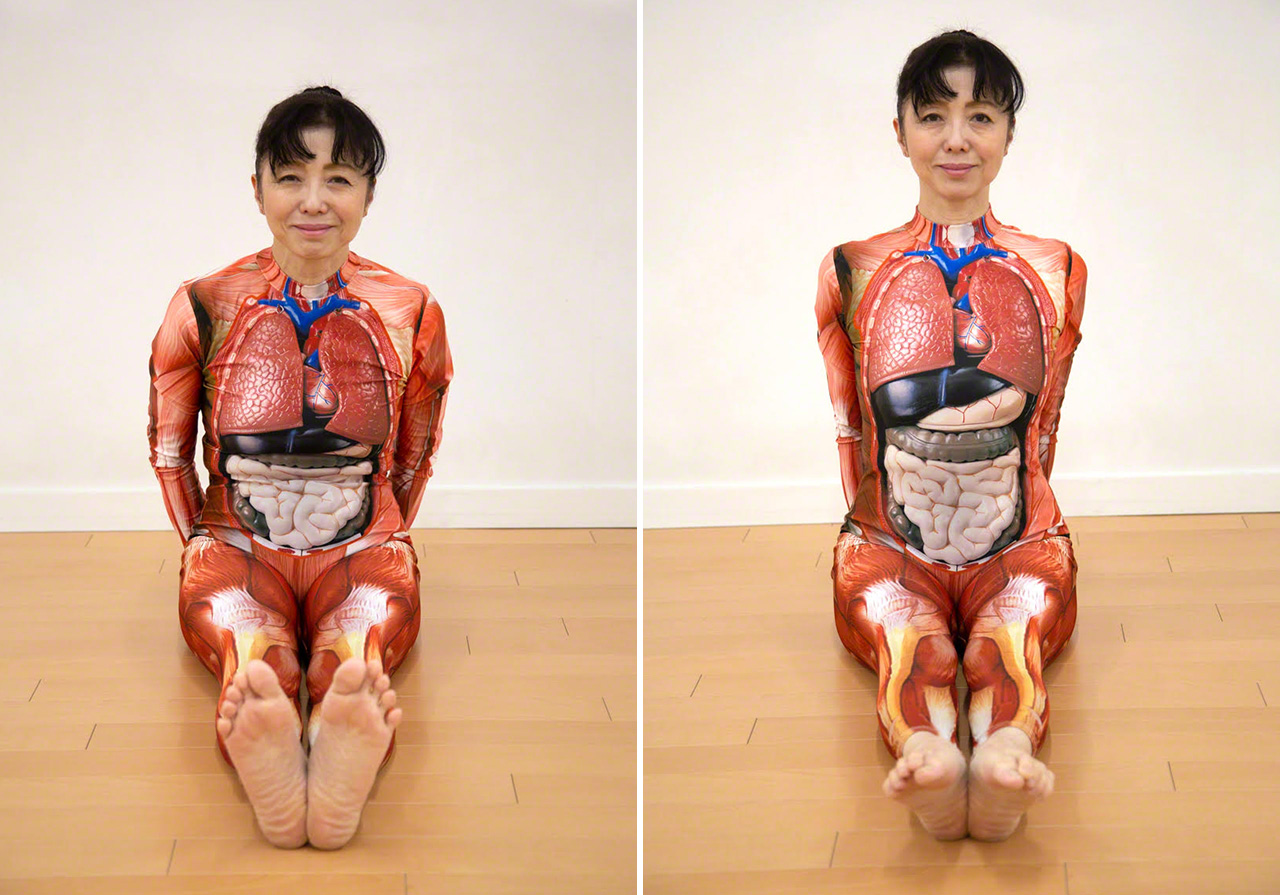
(© Ōnishi Naruaki)
Simple steps like this illustrate how dramatically we can improve the condition of our bodies just by being aware of the connection between our conscious minds and the microcosmos inside our bodies.
The Beginnings of a New Approach
Kikuchi was born in 1934, in an area that now lies within the city of Daisen in Akita Prefecture. As a child of two, she suffered serious burns when she dropped a rag into the irori fireplace and put her right hand into the fire to pick it up. Eventually doctors were able to separate the fingers that had been joined together by the burn, but it was some time before she fully recovered from the after-effects of the injury—including the mental impact of her schoolmates commenting on the blackened color that long remained in her fingernails.
The year after the war ended, she entered a high school for girls that was famous for its table tennis teams. Kikuchi fell under the spell of the game and vowed to become a player herself, but found it hard to grip the paddle. She suspended a ping-pong ball from the ceiling of the family home and spent hours practicing. She now says that this experience, in which she spent long hours consciously forging connections between her brain and each of her fingers, was the starting point for what later developed into Kikuchi gymnastics.
She graduated from Japan Women’s Junior College of Physical Education and became a physical education instructor at a junior high school, but soon had her doubts about how the subject was taught in schools. Although the purpose of physical education was purportedly to teach students to keep themselves physically fit for life, the priority in PE classes always seemed to be to get students to perform a given exercise better than their peers, or with aesthetically pleasing form. She got married not long after and left her job when she had her first child.
Kikuchi gymnastics began when Kikuchi was approached by other women living in the same housing complex, asking her to teach a gymnastics class. The first classes took place in the apartment communal recreation space. This was in the late 1960s, around 55 years ago. In those days, the idea of middle-aged women taking part in an amateur gymnastics class in their spare time would have struck many people as outlandish, so Kikuchi and her friends put up curtains to ensure privacy and protect the classes from prying eyes.
From the earliest days, Kikuchi used anatomical illustrations to explain why a particular movement was necessary. She admits that many of her students told her they found these pictures off-putting. But Kikuchi’s classes soon earned a reputation for being an effective way of maintaining physical health and strength, and she was approached by the education committee of Yokohama to organize classes for people in that city. From the early 1980s, she decided that the name “gymnastics” (taisō in Japanese) was necessary, and Kikuchi gymnastics got its full name for the first time.
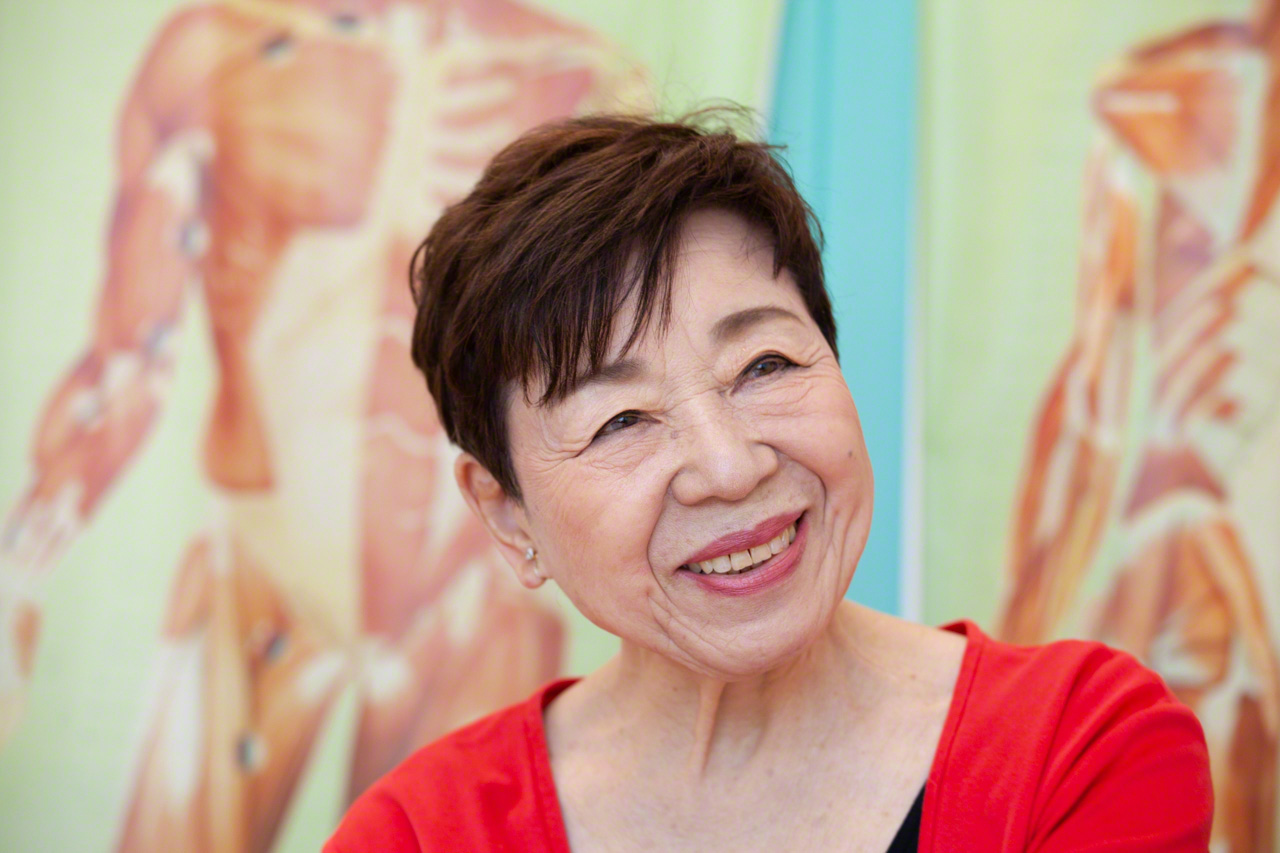
Kikuchi enjoys a clear, blemish-free complexion even at 90. (© Ōnishi Naruaki)
Mutual Encouragement
Kikuchi still teaches today, each class lasting an hour and 15 minutes, at her main studio in Kawasaki. Nearly 50 students attend each class, most of them middle-aged and older women. As soon as Kikuchi appears, dressed in a black leotard and stylish red top, the atmosphere in the room changes. From the moment she enters the studio until the session is finished, she never stops moving, never stops talking. There is not a single moment of rest. Even the anatomical models seem to stand to attention when Kikuchi is talking.
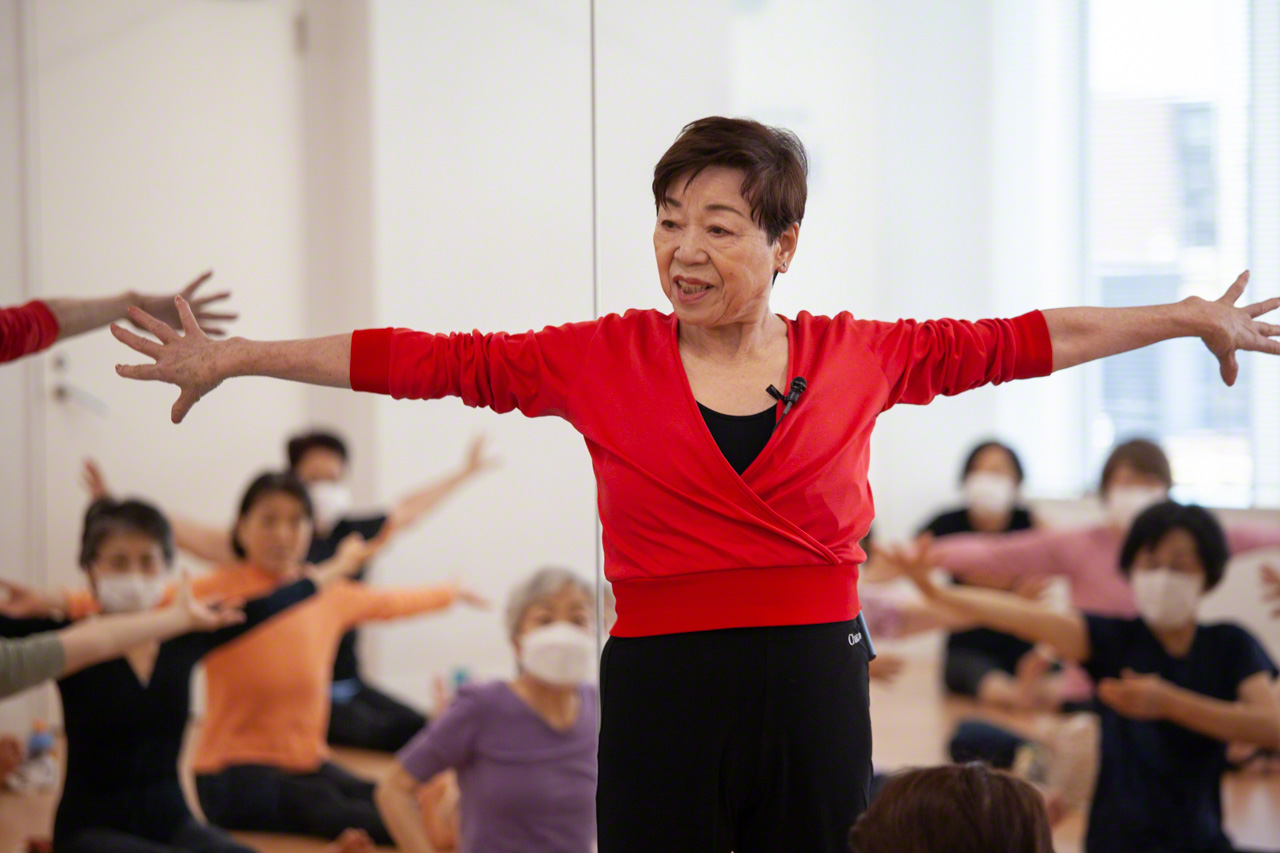
Each lesson begins by gathering the energy or “ki” of all the participants. (© Ōnishi Naruaki)
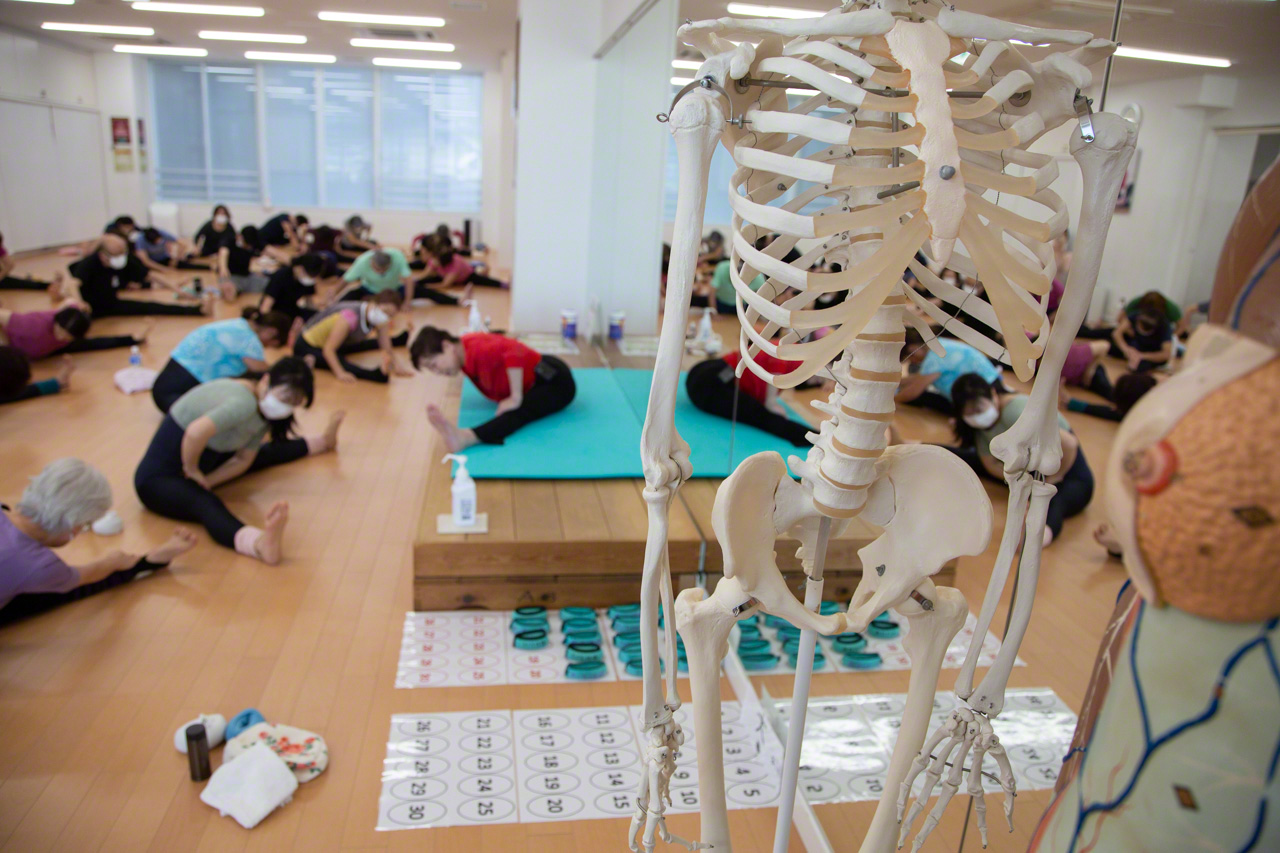
Anatomical models are a constant presence wherever Kikuchi teaches her classes. (© Ōnishi Naruaki)
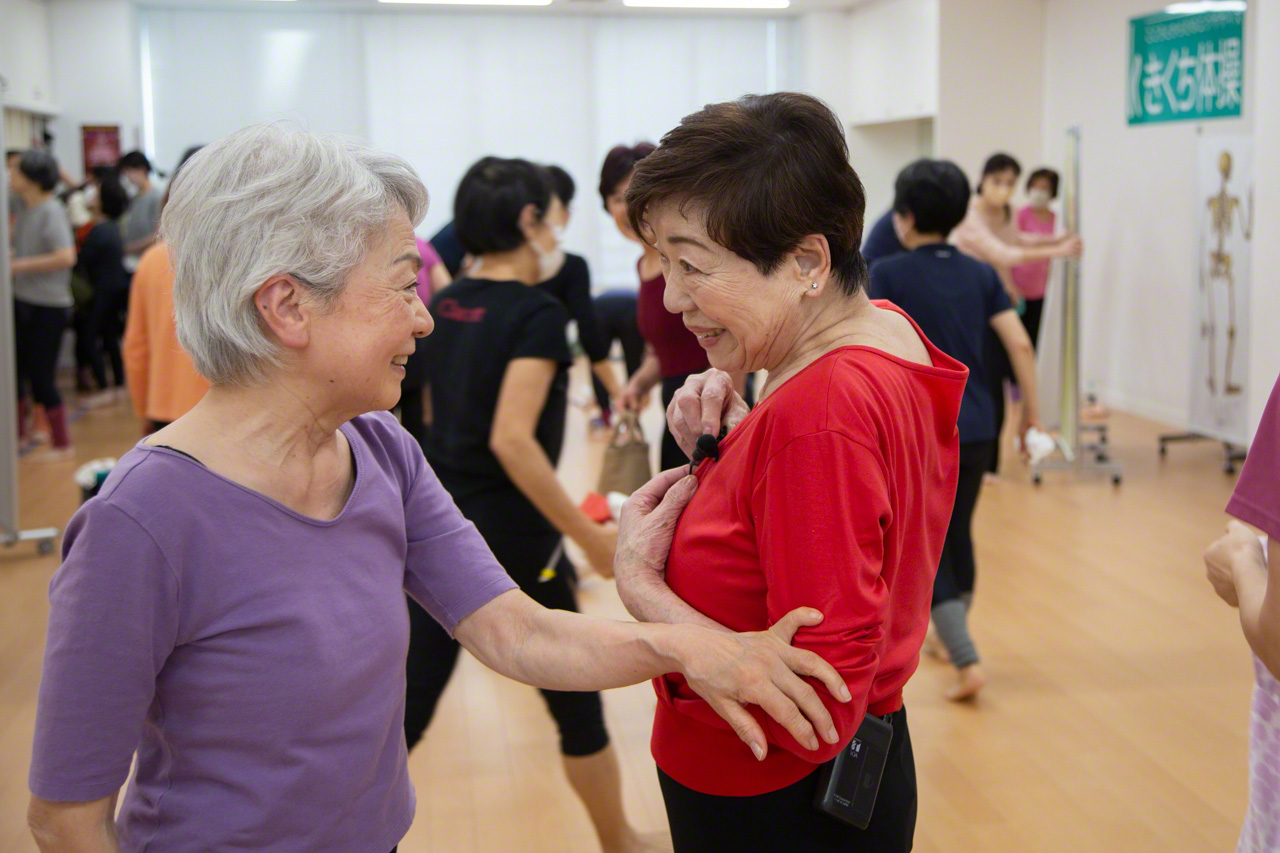
Kikuchi knows at a glance how her regular students are doing. Here she exchanges a few words with Sadotomo Junko. (© Ōnishi Naruaki)
One person who has been taking part for 17 years is 82-year-old Sadotomo Junko. “When I started coming, I could barely make it across a pedestrian crossing without getting out of breath. I always carried nitroglycerine in case I had an attack of angina. But I kept coming, two or three times a week, and I can’t tell you how much better I feel now. It’s hard to believe I was ever so weak. And if problems do happen, knowing that I can resolve them on my own is a great help. It’s thanks to these classes that I have made it through to the age I am now without any major problems. We always get a pep talk before each class. Her words are so moving and encouraging they always make me determined to keep going and do the best I can.”
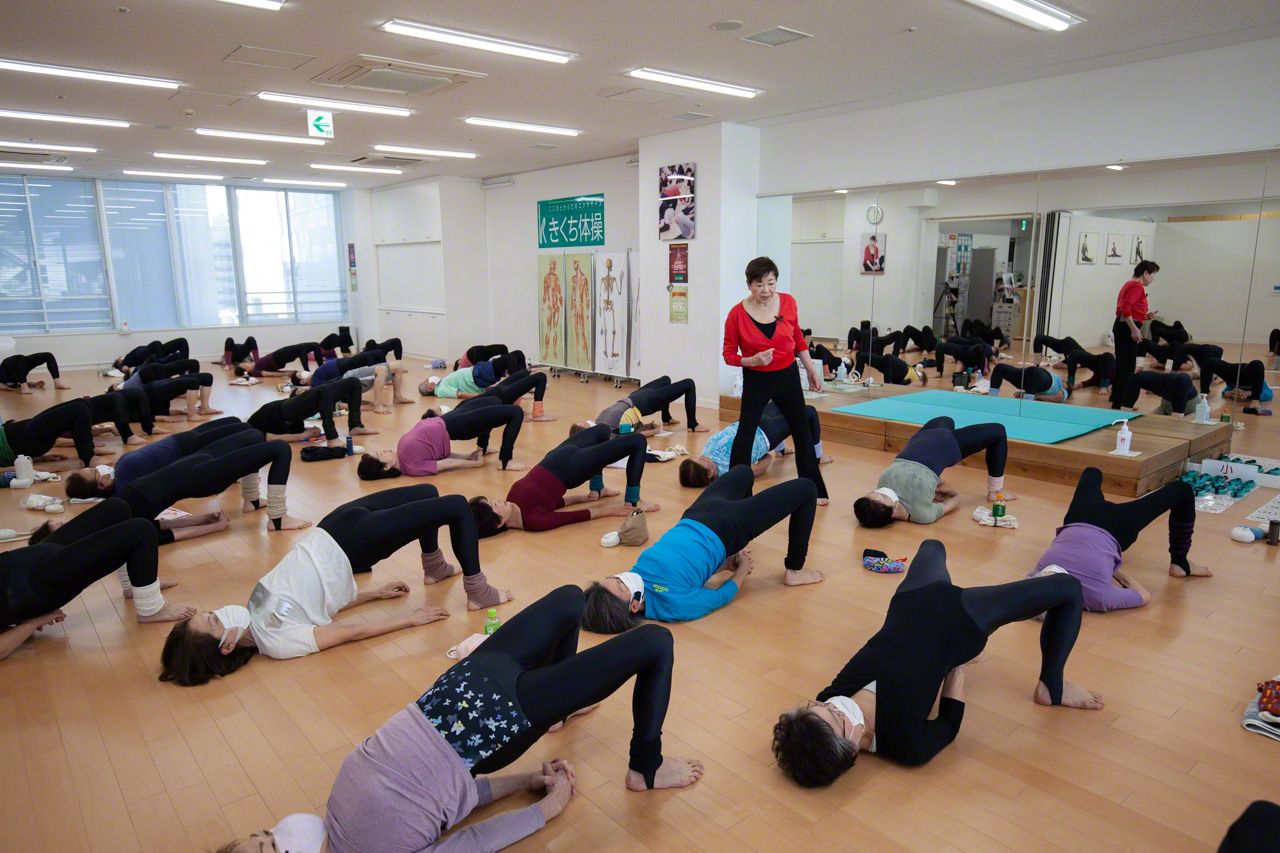
Kikuchi talks to her students all through the class, and is constantly on the move, keeping a close eye on every movement her students make. (© Ōnishi Naruaki)
A Special Place with a Power to Heal
Watching the lessons, I am struck by how powerful a presence Kikuchi is, and by how meaningful it is for the students to see their apparently ageless teacher standing like an indomitable mountain or mighty tree in front of their eyes. Nothing could provide a more persuasive demonstration of the truth of what she is teaching. Kikuchi’s aura of energy and strength creates a special space that inspires and stimulates every member of her classes.
Most of those people are women. I exchange a few words with one of the few male students, Kawamoto Kiichi (a retired IT engineer in his early eighties), who laughs when I ask him to describe the classes. “The instructor keeps a careful eye on every one of us. There’s no escape! The energy she gives off is quite something. It’s almost frightening sometimes. She certainly gives me a good workout every week. I’m practically gasping by the end of the session.” Kawamoto says with a note of surprise that he’s been coming to classes for seven years now.
He previously suffered from an elbow injury sustained playing tennis and had to have an operation to treat a worsening hernia. Since he started attending Kikuchi’s classes, he says his elbow pain has improved and he has greater strength in his legs. He also credits her classes with helping a long-standing bladder problem. There is an unmistakable atmosphere in Kikuchi’s studio of a salvific power backed up by the feeling of reassurance that comes from sharing time with a mentor and other like-minded people in a special space.
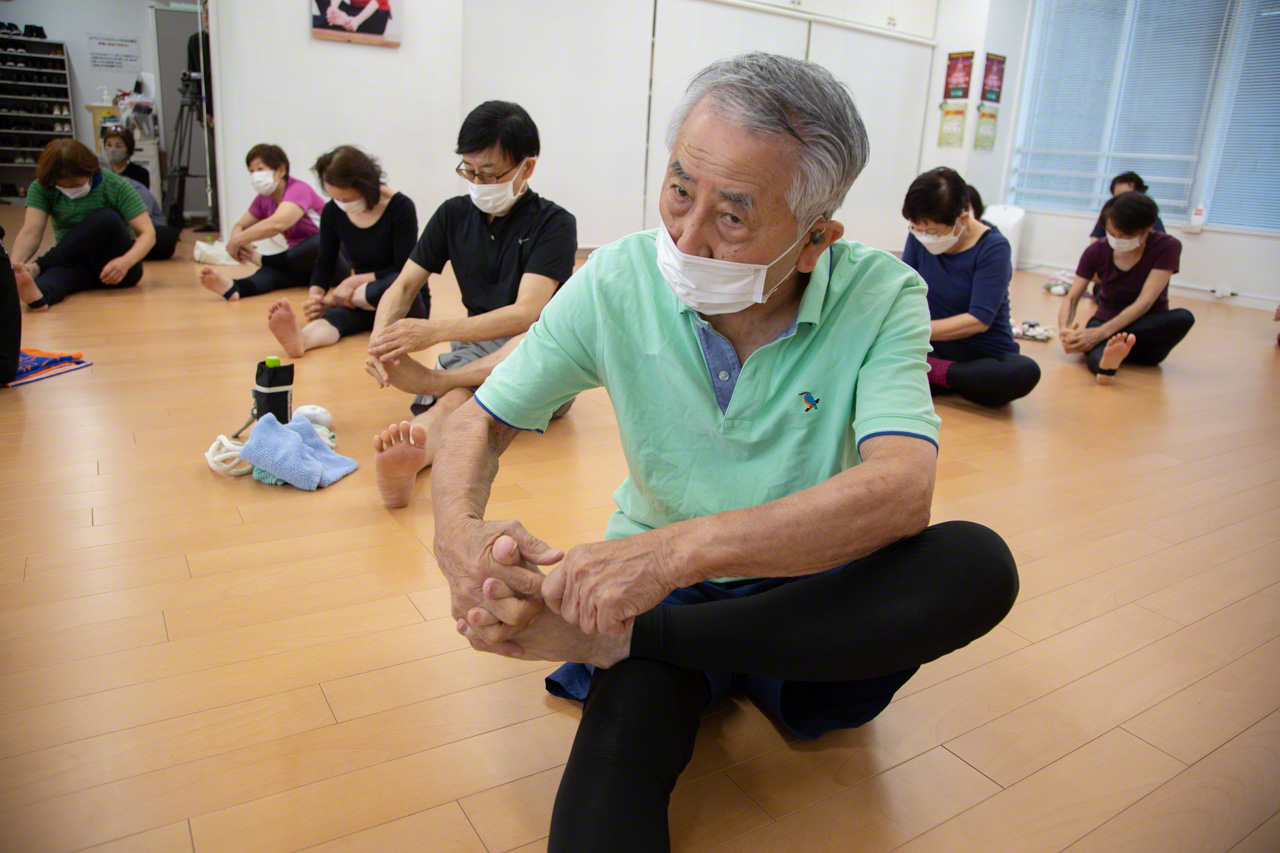
Kawamoto Kiichi’s spritely movements belie his 83 years. (© Ōnishi Naruaki)
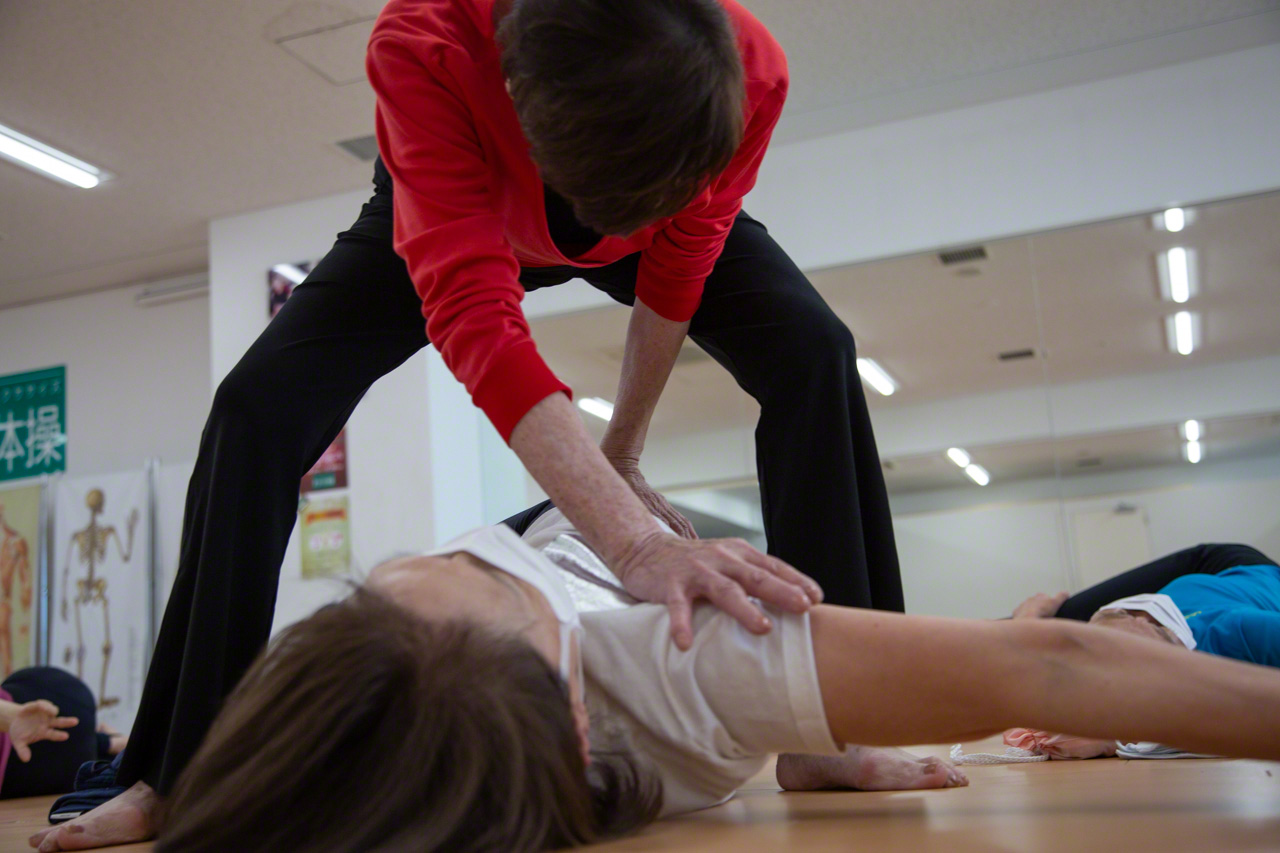
Kikuchi gives an injection of ki (healing spiritual strength) to people who are feeling weak or struggling with worries. (© Ōnishi Naruaki)
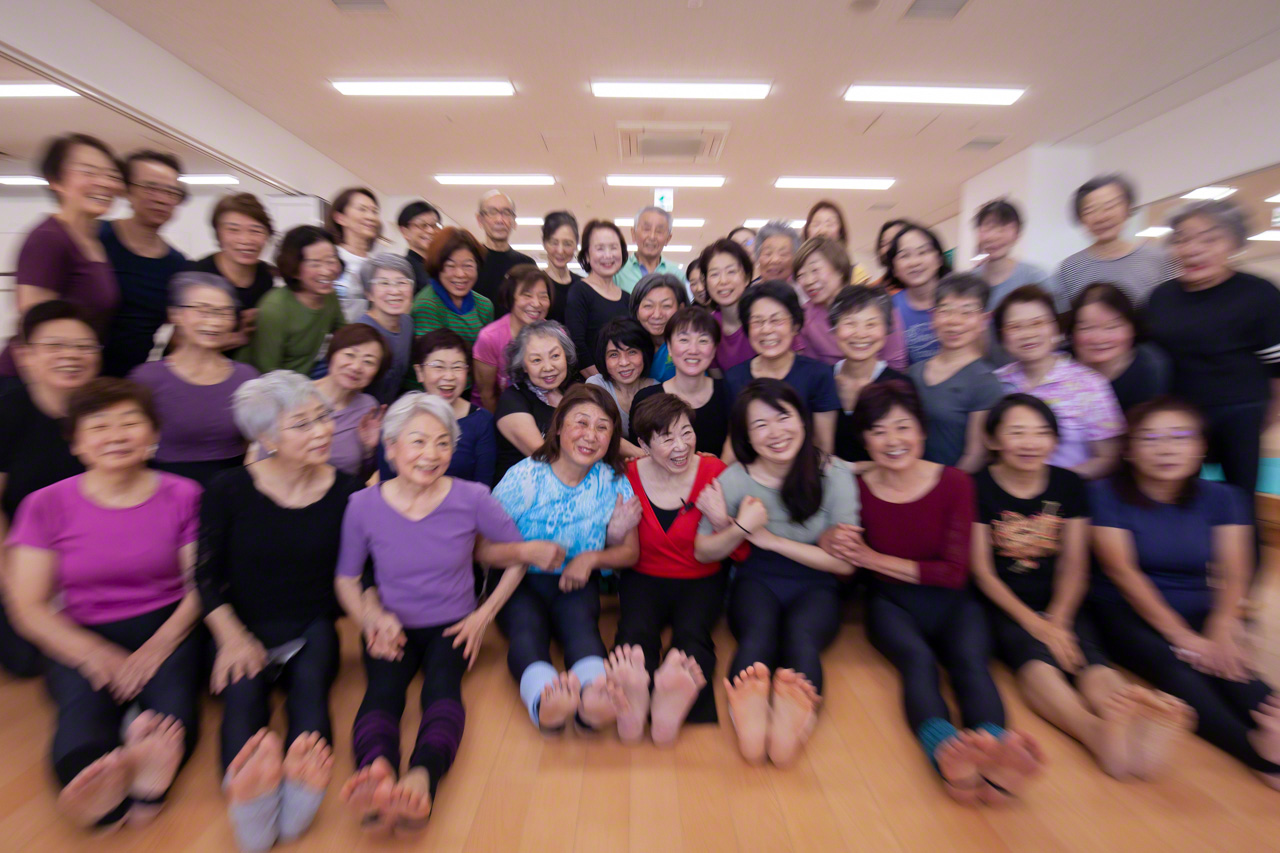
A souvenir picture at the end of class. A new energy seems to surge from the revitalized participants. (© Ōnishi Naruaki)
Circle of Life
“Let me show you another trick we do from time to time,” Kikuchi says, before demonstrating a strange exercise like nothing I’ve seen before.
The “exercise,” if that’s the right word, involves a chain of interlocking hands and feet. It starts with two people seated opposite each other on the ground, their toes intertwined. They feel each other out with their toes, taking notice of the shape and feel of the other person’s feet, and seem to pool their strength together. Then they interlock their fingers. This naturally gives rise to smiles. Then they join together the strength in their arms, shoulders, and stomach muscles.

To start with, two people sit opposite each other and join their fingers and toes together. Getting a tactile “feel” for the other person is important. (© Ōnishi Naruaki)
A call comes to try the same thing again, but this time with four people. They sit together and grip one another’s hands and feet and gradually form a perfect circle.
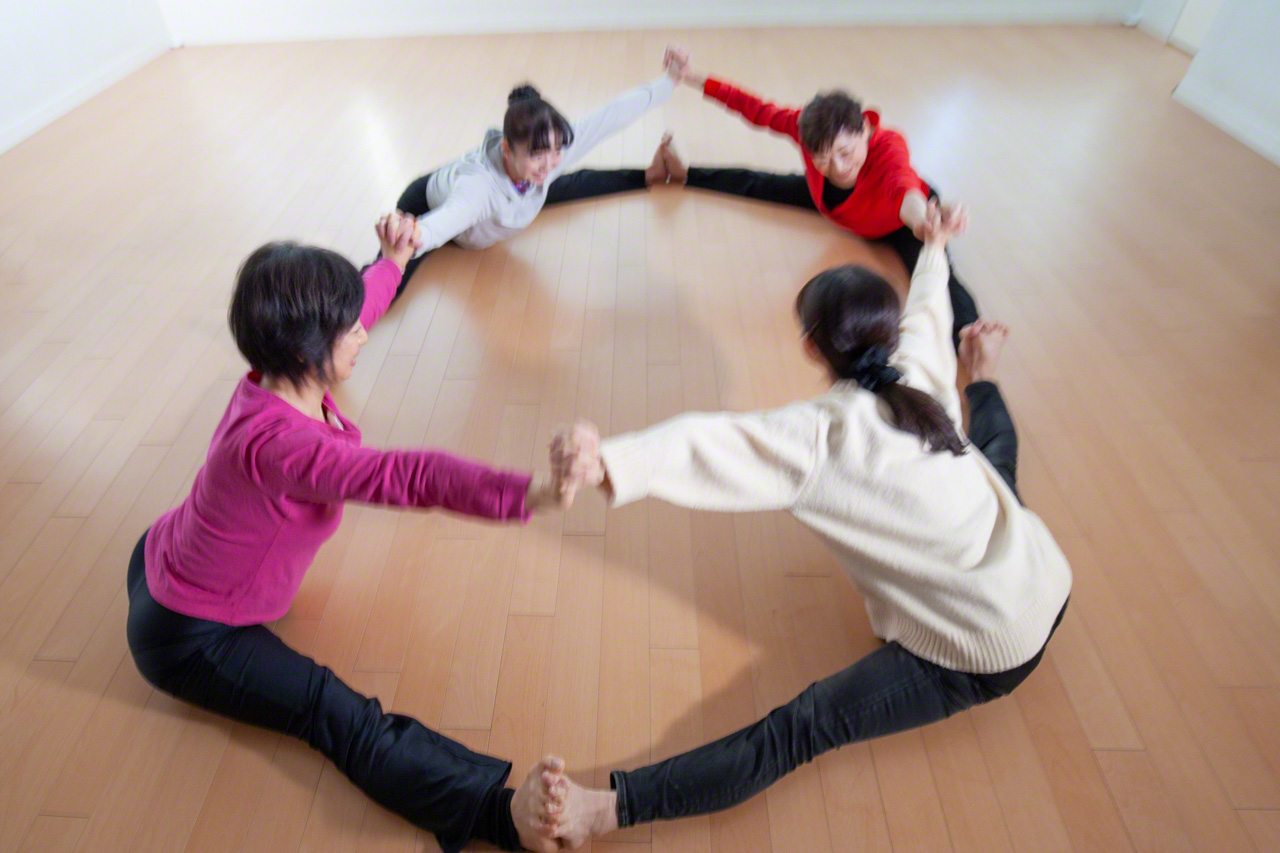
This form of connection brings smiles and a return to childish innocence. (© Ōnishi Naruaki)
I watch as the four egos melt together. As they form their circle, I seem to see them becoming a single living entity in front of my eyes. I am suddenly overwhelmed by a strange sense that I too am being lifted up, as though my own body is beginning to resonate with this shared sense of togetherness. If only all the people in the world could join their hands—and feet—together like this, I think, from the bottom of my heart.
It is a moment of supreme happiness that can come from the loss of the self, a blurring of the dividing lines between self and others. A moment of realization: we are all connected. Something stirs that normally slumbers deep inside: a childlike innocence.
For half a century now, Kikuchi has been working to cultivate something through her unique brand of calisthenics—more and more, it strikes me that what she has been building is precisely this sense of togetherness and shared investment in a better future. It is a reminder of something important that is being lost from contemporary society—and a reminder that the human body is naturally full of hope.
(Originally published in Japanese. Photographs and text by Ōnishi Naruaki. Banner photograph: Kikuchi Kazuko with some of the anatomical models that are a fixture of her studios. © Ōnishi Naruaki.)
